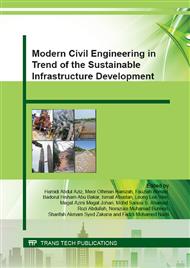[1]
Malaysia Palm Oil Council (MPOC), Malaysia palm oil industry. Available from <http: /www. mpoc. org. my/Malaysian_Palm_Oil_Industry. aspx>. [8 October 2014].
DOI: 10.19103/as.2017.0018.05
Google Scholar
[2]
Selena Sironi, Laura Capelli, Paolo Ce´ntola, Renato Del Rosso, Massimiliano Il Grande. Continuous monitoring of odours from a composting plant using electronic noses, Waste Management 27 (2007) 389–397.
DOI: 10.1016/j.wasman.2006.01.029
Google Scholar
[3]
Laura Capelli, Salena Sironi, Renato Del Rosso, Paolo Centola, and Massimiliano Il Grande. A Comparative and critical evaluation of odour assessment methods on a landfill site, Atmospheric Environment 42 (2008) 7050-7058.
DOI: 10.1016/j.atmosenv.2008.06.009
Google Scholar
[4]
Parveen Fatemeh Rupani, Rajeev Pratap Singh, M. Hakimi Ibrahim and Norizan Esa. Review of Current Palm Oil Mill Effluent (POME) Treatment Methods: Vermicomposting as a Sustainable Practice, World Applied Sciences Journal 11(1) (2010) 70-81.
Google Scholar
[5]
Laura H. Page, Ji-Qin Ni, Albert J. Heber, Nathan S. Mosier, Xingya Liu, Hung-Soo Joo, Pius M. Ndegwa, Joseph H. Harrison. Characteristics of volatile fatty acids in stored dairy manure before and after anaerobic digestion, Biosystems Engineering 118 (2014).
DOI: 10.13031/2013.42164
Google Scholar
[6]
Yee-Shian Wong, Tjoon-Tow Teng, Soon-An Ong, M. Norhashimah, Jing-Yong Leong, M. Rafatullah. Methane gas production from palm oil wastewater — An anaerobic Methanogenic degradation process in continuous stirrer suspended closed anaerobic reactor, Journal of the Taiwan Institute of Chemical Engineers 45 (2014).
DOI: 10.1016/j.jtice.2013.10.002
Google Scholar
[7]
Ye Chen, Jay J. Cheng, Kurt S. Creamer. (2008). Inhibition of anaerobic digestion process: A review, Bioresource Technology 99 (2008) 4044-4064.
DOI: 10.1016/j.biortech.2007.01.057
Google Scholar
[8]
David M. Babson, Karen Bellman, Shaurya Prakash, Donna E. Fennell. Anaerobic digestion for methane generation and ammonia reforming for hydrogen production: A thermodynamic energy balance of a model system to demonstrate net energy feasibility, Biomass and Bioenergy 56 (2013).
DOI: 10.1016/j.biombioe.2013.05.024
Google Scholar
[9]
Salar Haghighatafshar, Hamse Kjerstadius, Jes la Cour Jansen, Asa Davidsson. Management of hydrogen sulfide in anaerobic digestion of enzyme pretreated marine macro-algae, Journal of Water Management and Research 68 (2012) 265–273.
DOI: 10.2166/wst.2013.486
Google Scholar
[10]
M. Lateb, C. Masson, T. Stathopoulos, C. Bedard. Effect of stack height and exhaust velocity on pollutant dispersion in the wake of o building, Atmospheric Environment 45 (2011) 5150-5163.
DOI: 10.1016/j.atmosenv.2011.06.040
Google Scholar
[11]
C. H. Burton, R. W. Sneath, T. H. Misselbrook, B. F. Pain. The effect of farm scale anaerobic treatment of piggery slurry on odour concentration, intensity and offensiveness, J. agric. Engng Res 71 (1998) 203-211.
DOI: 10.1006/jaer.1998.0313
Google Scholar
[12]
Marjaleena Aatamila, Pia K. Verkasalo, Maarit J. Korhonen, Anna Liisa Souminen, Maija-Riitta Hirvonen, Marja K. Viluksela, Aino Nevalainen. Oodur annoyance and physical systems among residents living near waste treatment centres, Environmental Research 111 (2011).
DOI: 10.1016/j.envres.2010.11.008
Google Scholar
[13]
V. Belgiorno, V. Naddeo, T. Zarra, Odour Impact Assessment Handbook, first ed., Wiley, (2013).
DOI: 10.1002/9781118481264.ch7
Google Scholar
[14]
R. Stuetz, F.B. Frechen, Odours in Wastewater Treatment, Measurement, Modelling and Control, IWA Publishing (2001).
Google Scholar
[15]
N. Qamaruz Zaman, R.N. Rosli, N. Yaacof, The Odour Threshold Test, A Tool of Odour Assessment: Preliminary Observation. Available from <https: /www. academia. edu/5177842/Nqz040613 >. [15 April 2015].
Google Scholar
[16]
Anne-Claude Romain, Julien Delva, Jacques Nicolas. Complementary approaches to measure environmental odours emitted by landfill areas, Sensors and Actuators B 131 (2008) 18–23.
DOI: 10.1016/j.snb.2007.12.005
Google Scholar
[17]
N. Hudson, G. A. Ayoko, M. Dunlop, D. Duperouzel, D. Burell, K. Bell, E. Gallagher, P. Nicholas, N. Heinrich. Comparison of odour emission rates measured from various sources using two sampling devices, Bioresource Technology 100 (2009) 118-124.
DOI: 10.1016/j.biortech.2008.05.043
Google Scholar
[18]
Aijuan Zhou, Zechong Guo, Chunxue Yang, Fanying Kong, Wenzong Liu, Aijie Wang. (2013).
Google Scholar
[19]
Parviz Mohammadia, Shaliza Ibrahima, Mohamad Suffian, Mohamad Annuar. High rate fermentative hydrogen production from palm oil mill effluent in an up-flow anaerobic sludge blanket-fixed film reactor, chemical engineering research and design 92 (2014).
DOI: 10.1016/j.cherd.2014.04.023
Google Scholar
[20]
Sven Nimmermark. Influence of odour concentration and individual odor thresholds on the hedonic tone of odour from animal production, Biosystems Engineering 108 (2011) 211-219.
DOI: 10.1016/j.biosystemseng.2010.12.003
Google Scholar


